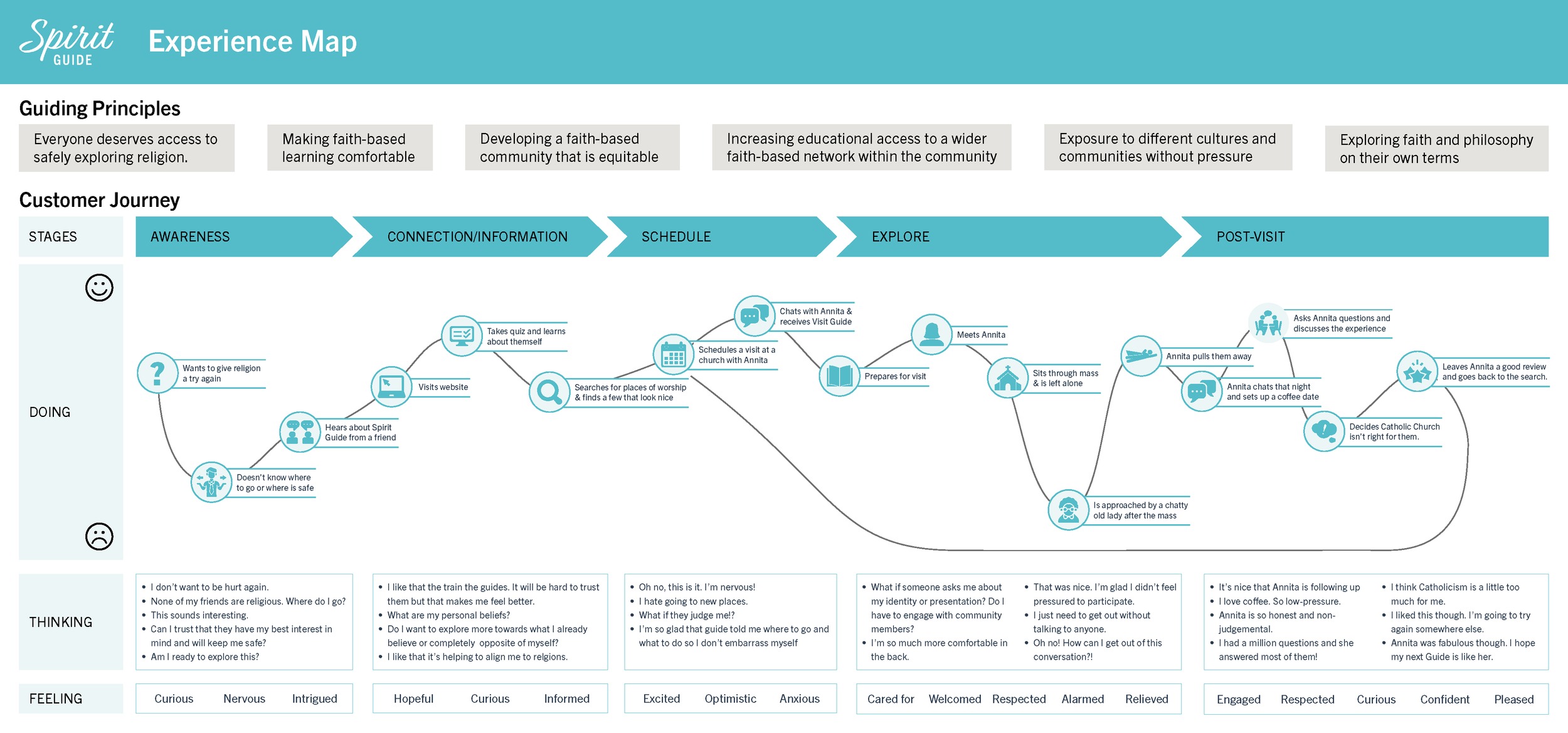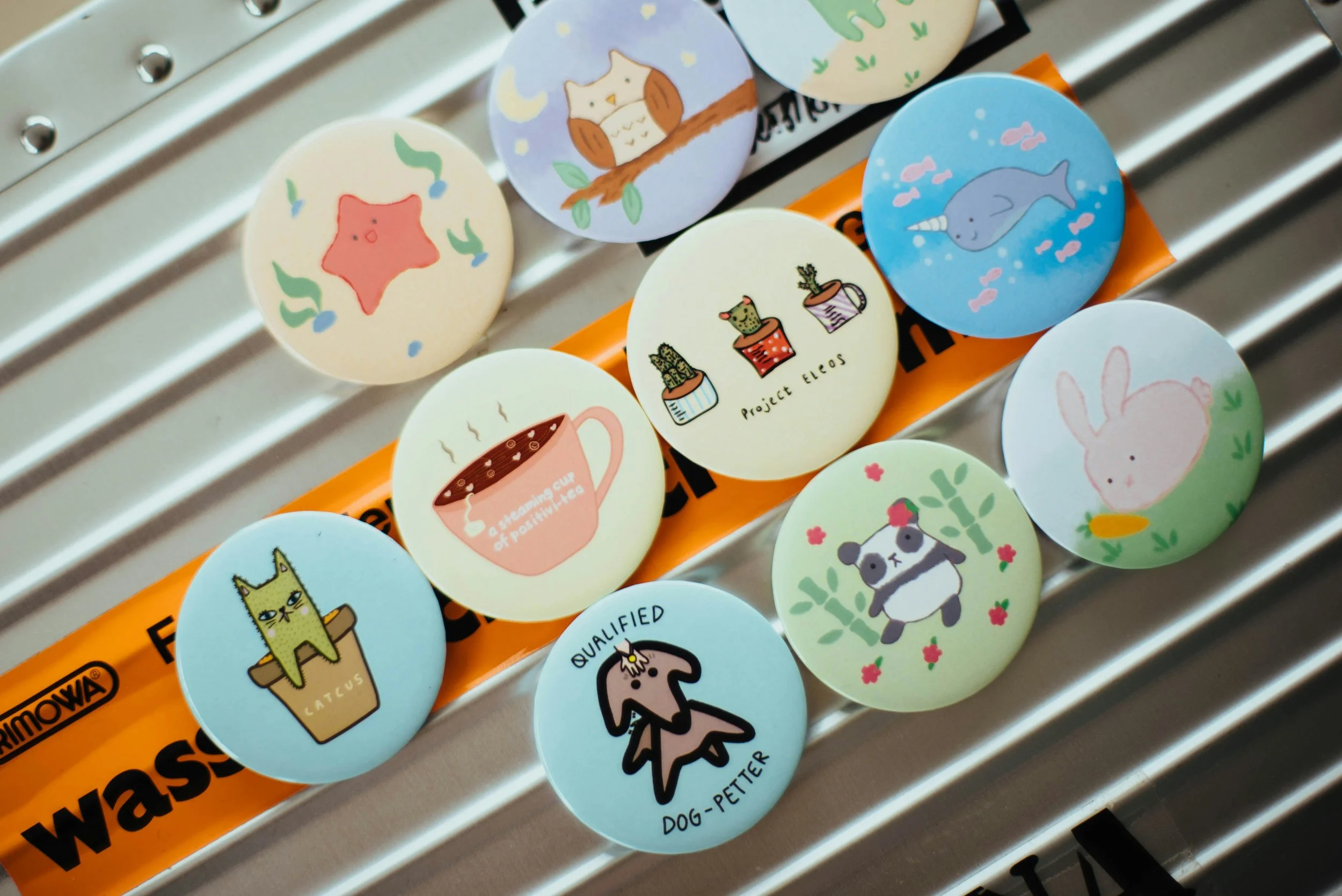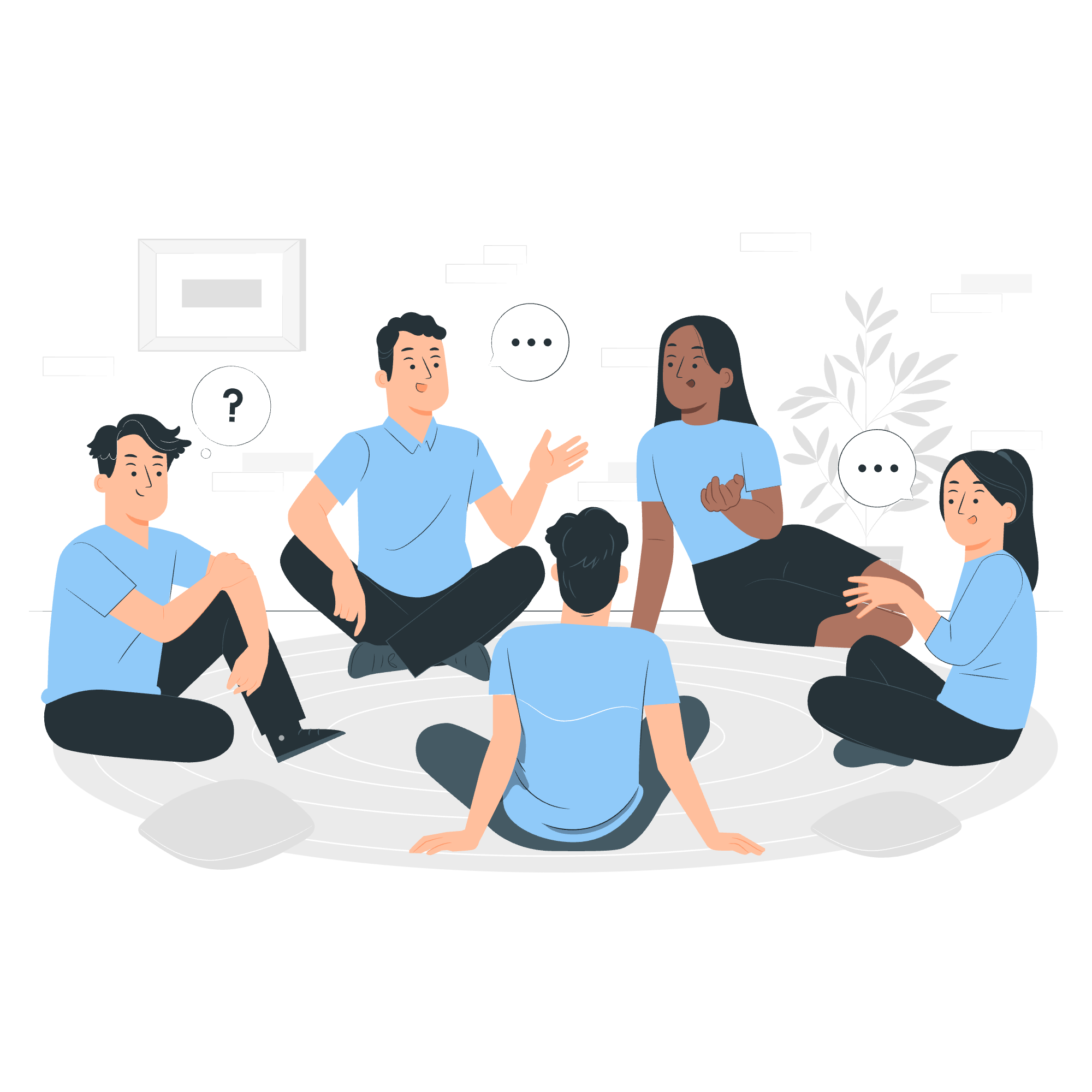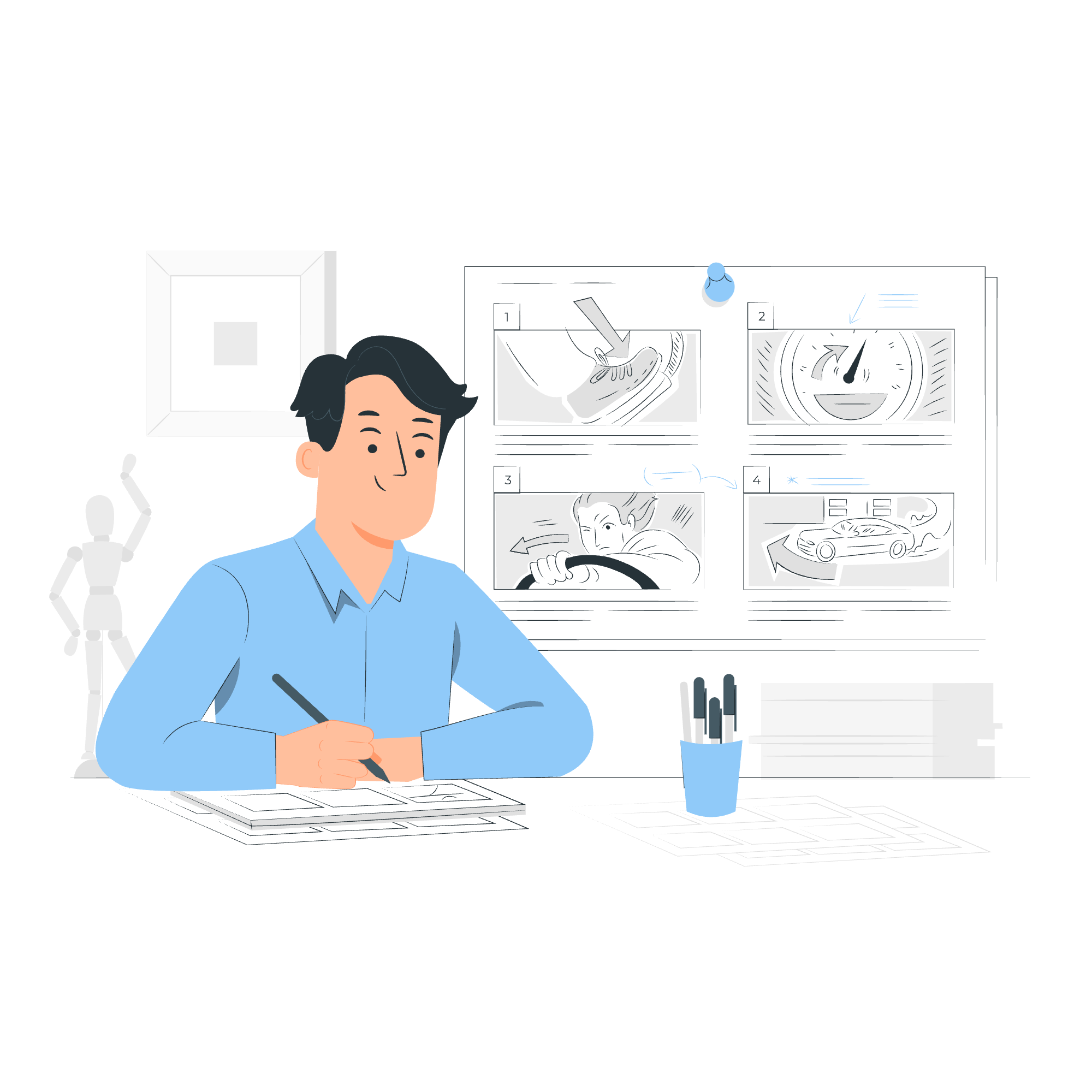‘23
Young adults exploring faith and spirituality have no starting point.
Timeline: 8 wks. (4-person team)
UX Design and Content: This project showcases the high-level overview of a concept developed and pitched to a Portland, OR client. While the client retains ownership of the final deck and wireframes, this walkthrough highlights the process work, including the strategic approach, ideation, and design methodology that created the concept.
Faith leaders in Portland, OR grow concerned about declining attendance at spaces across the community.
The challenge: Design a conceptual platform that encourages a safe, welcoming space to explore, ask questions, learn about, and join a new faith-based or spiritually-led community.
Spirit Guide is a hybrid experience that offers 1:1 personalized support, educational resources, cultural insights, virtual tours, and opportunities to visit local worship spaces and events.
The goals of Spirit Guide are to develop a pipeline for young adults to become integrated into spiritual and faith communities throughout Portland and address social misconceptions about traditional faith-based institutions.
For the purposes of this design, the terms faith and spirituality are often used interchangeably to represent personal and flexible explorations of meaning, connection, and belief. The term religion specifically refers to structured systems with organized practices, shared traditions, and collective communities.
Explore how Spirit Guide works.
-

Discover
So, you’ve found Spirit Guide! Create an account on our platform to get matched.
-

Explore
Start here. Take our onboarding questionnaire to explore your core beliefs and values. Then, learn about how your foundation aligns with other communities.
-

Plan
You’ve found some matches. Great! When you’re ready to visit a local space, find and chat with a guide who can walk you through everything you need to know to book a visit.
-

Visit
This is a big step. You want to see what the space is all about. Meet your guide and experience the community in person.
-
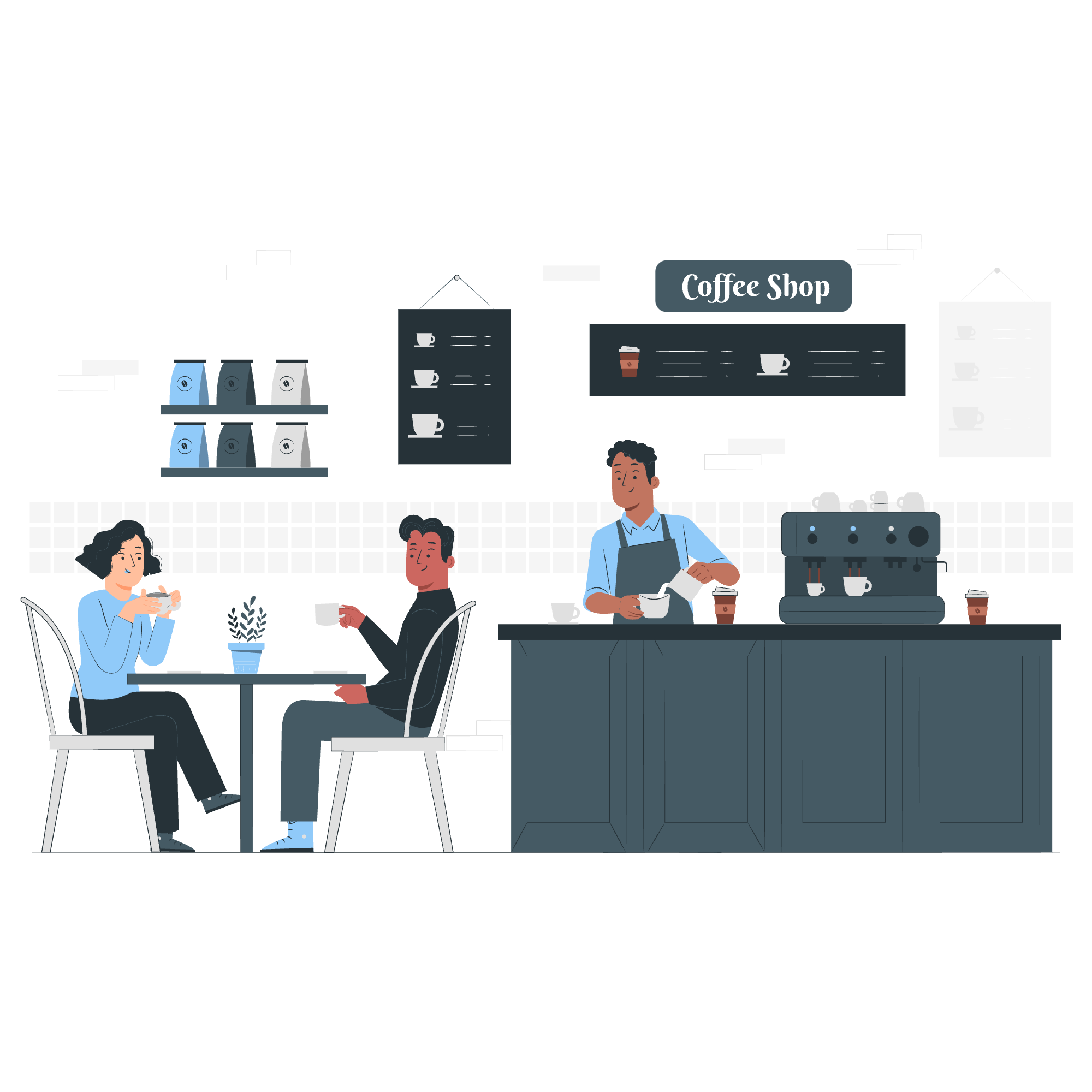
Next Steps
How did it go? No pressure to join now. Schedule a time to chat with your guide about what went well and what didn’t. And if it’s not a fit, you can explore other spaces on the platform.
Scroll through to check out the process work to develop Spirit Guide.
Don’t miss my “lessons learned” at the bottom of the page!
Research and Discovery
High-level insights from interviews and our guiding definition
Personas and Mapping
A look at people journeys that crafted the end-to-end experience
Ideation and Prototyping
Pulling it all together (kind-of)!
Low-Fi Mockups and Testing
High-level insights from dogfooding and community group presentation
Research and Discovery
People had a lot to say about their experiences. We listened and learned. Their stories also revealed (3) core themes.
For young adults, the period of life is often marked by a profound search for meaning, identity, and a deeper understanding of the world and one’s place in it. This is even more true for those with intersectional identities, which play a significant role in shaping (often traumatic) previous faith experiences, specifically for non-white and LGBTQ+ communities. We wanted to design an environment where people feel comfortable sharing their questions and curiosity, knowing they will be met with understanding and respect.
Participant, Community Conversations
"A few years back I went on a ‘faith exploration’ to research and possibly try out different denominations and even different faiths. I was raised in an extreme evangelical sect (old-fashioned Assembly of God), which prompted me to stay away from all things religion for many years, until I had children. I ended up researching all forms of Christianity, including Mormons, Islam, and Buddhism. I eventually found my way back to Christianity, although I have to say Buddhism was a close second."
-
Personal Belief Struggles
They often struggle to reconcile their exploration of faith with existing beliefs or lack thereof, leading to feelings of guilt or confusion as they question their upbringing, adopt new beliefs, or identify as agnostic or atheist.
-
Fear of Disrespect
They worry about unintentionally offending others by asking questions or engaging in unfamiliar practices. This fear can lead to self-censorship and inhibit the free exploration of religious and spiritual interests.
-
Lack of Guidance
Unlike childhood, where religion was guided by family or communities, young adults are left to navigate their beliefs independently, often without mentors or trusted advisors for support.
From our community conversations, we determined the needs and wants for this project.
What do people expect from our design?
What do people want to accomplish ?
Tailored Experiences that caters to unique interests, beliefs, and preferences, allowing people to freely navigate their exploration.
Educational Resources that help to explore and understand different belief systems, foster a sense of inclusivity and acceptance, and enable people to explore peer perspectives.
Low-pressure Environment to ask questions, engage in discussions, and learn without judgement or pressure to conform to any particular belief system.
Find a "Starting Point" with the ability to chose when, where, and how to begin their exploration.
Expand Perspective by learning about and empathizing with others' faith and spiritual experiences, and by adding their own voice to the narrative.
Gain Acceptance in a space where they feel valued and respected, regardless of their background or beliefs.
And, we defined a statement to guide our design process:
"Faith and spirituality should be a free, independent choice formed through tailored experiences and personal interactions in a low-pressure environment."
Personas and Mapping
Meet Anita, Frankie, and Jacob. Anita is the Passionate Community Liaison. Frankie is the the Skeptical Faith-Seeker. And Jacob is our Curious Cultural Explorer.
Frankie became the main persona, with Anita’s persona as the Spirit Guide.
So. many. ideas. We wanted Frankie’s journey to be end-to-end. That meant identifying five key touchpoints across digital and in-person spaces: Discover, Explore, Plan, Visit, Next Steps.
How does Frankie discover Spirit Guide?
How does Frankie connect to and explore different elements?
How do they figure out which guide to choose?
How does the visit reinforce a positive experience?
How do we close the loop?
In this stage, we threw everything at the wall. This is also where I began drafting questions and content for the onboarding questionnaire, chat simulation, and feedback survey. I expanded Frankie’s journey map and storyboard to capture detailed interactions.
Ideation and Prototyping
For initial sketches, wireframes, and mockups, our designers built out the site search, an education card, onboarding beliefs questionnaire, and the surveys for in-person and post-visit. I focused on crafting communication and details for each touchpoint and the in-person visit experience.
The in-person experience was critical for reinforcing a positive experience. To do this, I created a pin selection system that allows guests visiting a place of worship to choose their desired level of engagement. By offering three distinct options, the system honors personal preferences and meets individuals wherever they are on their spiritual journey.
Guest-guided visit experience
Upon arrival, guests are presented with a selection of three pins—Red, Yellow, and Green. Each pin is a simple, visual cue that communicates their chosen experience to both the place of worship staff and fellow visitors. The system is intuitive, empowering guests to navigate their visit on their terms. They can also be themed, fun, and discreet!
-

Green: Continuous Guidance
Guests choose to have a Spirit Guide accompany them throughout their entire visit for a deeper connection. Comfort in knowing a guide is present throughout their journey.
-

Yellow: Guided Flexibility
Guests check in briefly with a Spirit Guide but then explore the space independently. This provides a mix of guidance and autonomy. Opportunity for light interaction while maintaining control.
-

Red: Independent Exploration
Guests choose to experience the place of worship independently without any direct interaction. Freedom to explore at their own pace. Minimal to no contact for a quiet, personal reflection.
Low-Fi Mockups and Testing
We used dogfooding with the client before recruiting individual testers from the local community. Testers saw 25 mobile screens in Adobe XD and a separate deck that augmented the in-person experience.
Did people understand the point of Spirit Guide? Did they trust Spirit Guide? Did they understand the process? Did it feel authentic? How effective were the surveys in measuring guest experience?
Our team got great feedback to help clean up the process.
-
Outside factors need input.
"Keep in mind that other factors, such as people's friendliness, child care options, etc., can play a big role in a person's overall experience."
-
Trapped in onboarding.
"Do you have to sign up before you take the quiz? I would say let them take the quiz and ask them to sign up after."
-
Wording seemed off.
"Values seem different from a belief system, my values might not be the exact same as my belief system."
-
Wanted more visit options.
"Are there other ceremonies like bar and bat mitzvahs, so maybe aside from 'religious' ceremonies, you have been invited to attend, how often do you attend worship services?"
-
Why trust a Spirit Guide?
"I assume places of worship and guides are trained and vetted? It's not communicated at all, anywhere."
-
Frankie's journey is too easy.
"I have a hard time believing that Christian Catholic would feel like a good fit so quickly. Can you show more about how this develops in the plot line?"
Shifting from designing a complete experience to telling a complete story.
Our testers understood the point and purpose of Spirit Guide but wanted to see more intimate interactions, especially during key decision-making moments. We had components but no connection.
What happened during the visit? How did the interactions go? How did the guide address concerns? Does Frankie chat with community members? How important is the post-visit experience?
As we honed in the project for the pitch, we pared down the buildout (specifically the number of cards/frames for each touchpoint) and included a more personal, friendly tone across the experience with tightened wording and added calls to action. It was enough to showcase for potential further development. We also simplified the site map to streamline time from landing page to schedule a visit.
Reflecting on Spirit Guide
What did I learn?
You can't build out everything! (Especially before testing.) We focused so much on wanting testers to have a high-quality experiences that we got lost in our own process web. They noticed, and content suffered through the first round.
What went well?
Taking a step back to look at the entire end-to-end experience cycle and taking time to communicate each touchpoint did better than showing 25 frames and asking for feedback. As long as people fully understood the concept, the technical design execution could be given grace.
What could have gone better?
Scaling and scoping. Pick a few elements and craft them well.
What would I do for future development?
Focus on building out the in-person experience. How do people interact with the Spirit Guides during service? What touchpoints can be added in a physical space? How does the organic flow within a place of worship alter the experience for everyone? Also, based on feedback, expand the visit options to include cultural events outside of specific worship spaces.






